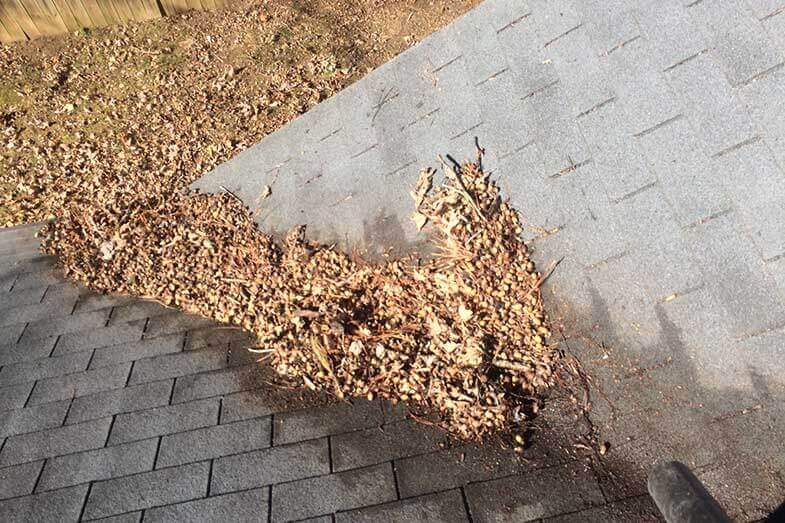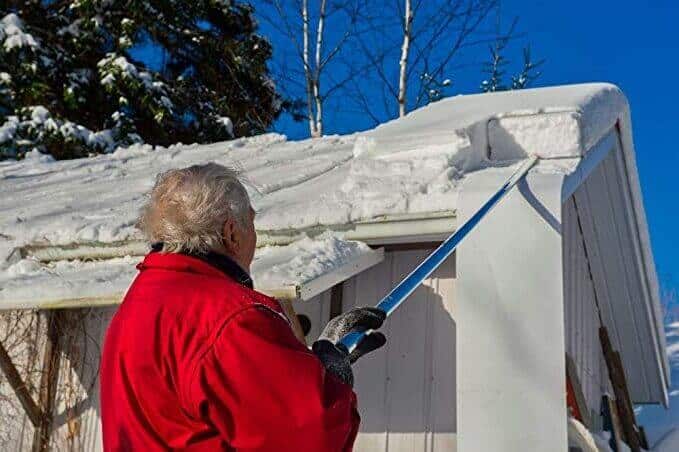The part of your house that is most subjected to wear and tear is the roof. It is constantly exposed to the sun’s scorching heat, rain, and other elements. If you are building a new home or are considering upgrading your roof, one of the most important considerations is how long the roof will last.
How long does a roof last? The amount of time a roof lasts will vary based on the type of roof material:
| Type of Roof: | How Long the Roof will Last: |
| Asphalt | 20 to 25 years |
| Wood | 25 to 30 years |
| Concrete and Clay tiles | 40 to 50 years |
| Synthetic | up to 50 years |
| Metal | 40 to 75 years |
| Slate | 100+ years |
Eventually, your roof will need to be repaired or even replaced. The material, its age, and the particular type of weather in your local area all major contributors to the longevity of your roof.
Expect to repair your roof often if you live in a hurricane zone. Big snowfalls will also make the lifespan of your roof will be shorter. You can minimize your repair costs if you schedule regular inspections and maintenance of your roof.
Repair your roof before you sell it in order to increase your home’s value. Installing a new roof in your house can increase its value to several thousands of dollars. You can check your house’s actual resale value if you consult a real estate appraiser.
Read on to learn more about how long a roof will last, including how to ensure it lasts as long as possible!
How Long Does a Roof Last? (Comparing 6 Different Materials)
The type of roofing material will influence how long a roof will last. Here are the different types of roof materials, their individual characteristics, and their expected lifespans. (sources: 1, 2)
1. Asphalt
Asphalt shingles are the most economical and one of the easiest to install. That is why it is the most popular roofing material in the United States. Asphalt is not the strongest roofing material, but you can reinforce it with cellulose or fiberglass to make them more durable.
They come in various colors. And because they are less expensive, they are available almost everywhere. Their quality varies and has shorter lifespans compared to other roofing materials. But you can adapt them in many roofing styles.
One square, which is a 10 x 10-foot area, ranges from $70 to $120. Environmentally resistant asphalt shingles can cost roughly around $2 to $4 per square foot. The lifespan of this roofing material can be from 20 to 25 years.
2. Wood
Wood shingles were the standard roofing materials in the past. It is a preferred roofing material for anyone wanting a classic look. When they age, wood shingles will acquire a grayish, aged earthy color, which makes them even more attractive. If you want a cozy, cabin-like, or rustic look for your roof, this is your choice.
Wood shingles are not appropriate for areas with wet climates. They are prone to rot, mold, and splitting. In some areas where fires are prevalent, the use of wood shingles is regulated. Shingles should have a fire-resistant coating in these areas.
Prices of wood shingles range from $100 to $150 per square. They will cost you around $4 to $7 per square foot approximately. Their lifespan could reach from 25 to 30 years.
3. Concrete and Clay Tiles
Concrete and clay tiles can make your house look elegant and stylish. They are available in different styles such as ribbed, flat, and scalloped. These roofing materials are very durable but are also very heavy.
To get the most out of them, you will need a professional to install them. Clay tiles are at a higher price point than most standard concrete tiles because they are made of authentic clay. But concrete tiles, if they are made of high-quality standards, can compete with clay tiles, as far as their appearance is concerned.
Concrete and clay tiles are perfect for Spanish-style homes, as well as Southwestern, Mission, and Mediterranean houses.
The price of concrete tiles ranges from $400 to $900 per square. Clay tiles are a bit more expensive, with prices that range from $700 to $1,000 per square. But they will provide you with a sturdy and elegant roof that can last from 40 to 50 years.
4. Synthetic Roofing
It is now possible, due to modern tech, to create new synthetic roofing materials that can compete with natural roofs in longevity, beauty, and functionality. They look indistinguishable from their original counterparts. Aside from being strong, they are also very easy to maintain. Some synthetic roofs are fire-resistant.
Synthetic roofing materials are not heavy, are not fragile, and are not as expensive as those made with organic materials. However, some of the latest products are not time-tested as their organic cousins.
Prices vary depending on the style, material composition, and strength. Their prices can range from a low of $165 per square to $250 per square (source). Most synthetic roofing materials can last for 50 years or more.
4. Metal
If your home is in a place that s subject to extreme weather conditions, your best option is a metal roof. It can be made of stainless steel, aluminum, zinc, or copper. They are available in shingles and panels.
If you want durability, a metal roof is your choice. Metal roofs can last longer than roofs made of wood or asphalt; however, they are more expensive. Their price ranges from $7 to $14 per square foot for styles with standing seams. The price range for granular-coated and press-formed panels is from $8 to $10 per square foot (source). Roofs made of metal will last from 40 to 75 years.
5. Slate
If you want a beautiful roof, slate is right up there with the best of the best materials. Slate has a distinctive and elegant look that is not seen in other roofing materials. It comes available in purple, red, gray, green, and black. This roofing material is also long-lasting. It is also fire-resistant, and you can recycle it when it is time to get it replaced.
The price of slate is much more expensive than most roofing materials. It is also heavy, and you need to frame it before installation. You also need to hire a professional to install it.
The price of slate is around $600 per square. Some types can be higher. Slate is also durable. It can last for more than 50 years. If it is made with high-quality standards and installed by a professional, it can last up to 100 years or even more.
What Determines How Long a Roof Lasts?

Several factors affect the lifespan of a roof. Here are some of these factors:
1. Water
Water freezes during cold weather and then thaws when the temperature rises. This process takes place periodically. If you don’t get your roof inspected, especially when freezing and thawing take place, you might be faced with a hefty roof repair bill.
If you live in one of the Mid-Atlantic U.S. areas, your house is exposed to the type of weather where there is regular freezing and thawing of water. Your roof is the one most affected by this kind of weather.
When snow falls, there will be water runoffs. These runoffs will seep into the cracks in your roof. If the water freezes again because of the cold weather, it will expand and make the cracks even bigger. This situation will create more problems on your roof.
2. The Quality of the Shingle
Poor shingle quality can give your roof a lot of problems. Cheap shingles can also give you problems in the future. Buy the best shingle that you can afford. Don’t settle for roofing materials just because they are the cheapest in the market. Read the reviews of the type of shingles that you can afford before you buy them.
3. Your Local Climate
Your local weather plays a major role in how long your roof will last. If your home is in a place with a warm temperature climate, your roof may actually not last longer than if you are living in a colder area. Roofs in the north of the U.S. tend to last longer than Mid-Atlantic roofs, where it is slightly warmer. Mid-Atlantic roofs tend to last slightly longer than roofs in the South. (source)
Cracks can form on your roof if the weather fluctuates, e.g., daytime temperature is very hot, and the nighttime temperature is very cold. The longevity of your roof will also be affected if you, of course, live in a place that is subject to extreme weather.
4. The Quality of the Installation
The way your roofing material is installed also plays a major role in how long your roof will last. If it is installed by a professional, your roof will last longer. The professional installer follows certain installation standards to maintain their license and reputation.
However, if you choose to hire a non-professional to install your roofing materials because their fee is cheaper, you are liable to have a roof installed in ways that are not at par with the standards. You will likely encounter roofing problems in the future.
How to Make a Roof Last Longer

Extend the life of your roof, no matter which material, by following these tips:
Get Your Roof Inspected
After a violent storm, it’s a good idea to ask a roofing expert to inspect your roof. Roof inspectors have a trained eye that can spot problematic things that your untrained eyes can’t see. If you do this, you will be able to repair the problem before it gets bigger.
Ask a roofing expert to thoroughly inspect your roof once a year. Your roof should be inspected for blisters and cracks. Once the inspector sees them, repair them at once.
Pro-tip: I actually use a camera drone from time to time when I go to visit my parents. This lets me check out their roof for any debris. They still get an inspector to check out their roof from time to time, but a camera drone comes in handy to spot any immediate problems like pools of water or piles of debris.
Remove Puddled Water
If you have a flat roof, it is very important to remove standing or puddled water that forms after every rain or snowfall. Water will try to seep through the cracks and will damage your ceiling. Determine what causes water to puddle and eliminate the cause if you can. If you can’t solve the problem, ask a roofing expert to help you.
Remove Ice and Snow
Use a roof rake. A roof rake prevents you from having to climb up the roof (which is a very difficult task) to remove the ice and snow. The weight of the ice and snow can stress the roof and its supporting structure.
Remove Fungus and Algae
Fungus and algae are some of the most destructive elements on any rooftop. You can clean them out with a mixture of equal parts of bleach and water. Pour the mixture into a spray bottle and spray the areas where stubborn fungus and algae have accumulated.
Clean the Debris
The least you can do to prolong the life of your roof is to clean the debris that has accumulated on it. This will prevent water buildup, get rid of the unnecessary weight that causes sagging, and prevent premature aging of the roof.
Put Roof Cement on Lifted Shingles
Expect lifted shingles on your roof after every windstorm. When you see that there are lifted shingles on your roof, you should apply cement at once. If you do not do this, the next big windstorm might blow them off, which will be a bigger issue later on.
Trim Tree Branches and Limbs
Cut off any tree limbs or branches that look like they are about to fall on your roof. Even if they are not about to fall, these limbs and branches could cause water puddles to form on your roof after a rainstorm. They also block the sunlight that could otherwise dry the water out.
Conclusion – How Long Does a Roof Last?
How long does a roof last? The amount of time a roof lasts will vary based on the type of roof material:
- Asphalt: 20 to 25 years
- Wood: 25 to 30 years
- Concrete and Clay: 40 to 50 years
- Synthetic: up to 50 years
- Metal: 40 to 75 years
- Slate: 100+ years
The lifespan of your roof depends on the following factors:
- Water
- Quality of the shingle
- Quality of installation
- Local climate
To make your roof last longer, follow the below tips:
- Get your roof inspected
- Remove puddled water
- Remove ice and snow
- Remove fungus and algae
- Clean the debris
- Put roof cement on lifted shingles
- Trim tree branches and limbs
The type of roofing material you have is the biggest factor that determines how long your roof will last. But perhaps equally as important of a factor is your care and maintenance. Whatever type of roof you have installed, take care of your roof, keep it clean and inspect it often. This will make your roof last as long as it possibly can before having to replace it.

![How Long Does DayQuil Last? [How Long It Stays in Your System] how long does dayquil last](https://howchimp.com/wp-content/uploads/2021/06/how-long-does-dayquil-last-300x200.jpg)
![How Long Does DHL Take to Deliver? [DHL Delivery Time] How Long Does DHL Take to Deliver](https://howchimp.com/wp-content/uploads/2021/05/how-long-does-DHL-take-to-deliver-300x200.jpg)

![Read more about the article Tiny White Bugs in the Kitchen [What Are They and How to Get Rid of Them]](https://howchimp.com/wp-content/uploads/2022/05/tiny-white-bugs-in-the-kitchen-300x200.jpg)
